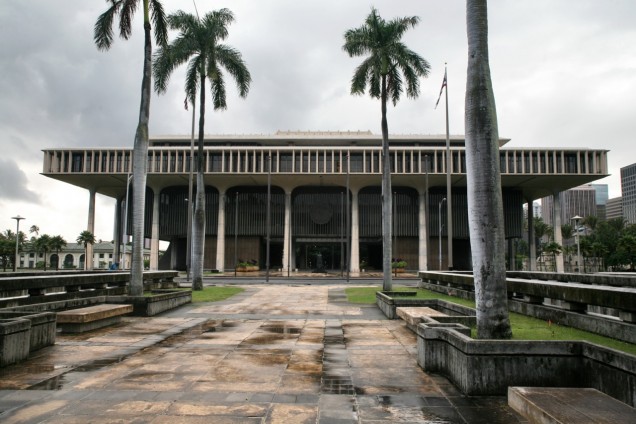By Lillian Feinberg
Up In Smoke (and Vapor): Hawai’i Raises Minimum Smoking Age and Regulates E-Cigarettes
On January 1, 2016, Hawai’i became the first state in the nation to increase smoking age restrictions to 21 years old. Under Act 122, Hawai’i prohibits the “sale, purchase, possession or consumption of cigarettes, other tobacco products, and electronic smoking devices (or e-cigarettes) to anyone under age 21.” Before Hawai’i, only municipalities such as New York City and Needham, Massachusetts restricted tobacco sales to individuals under 21 years old. States however, remain more conservative, with Alabama, Alaska, New Jersey, and Utah increasing the minimum age to buy tobacco to 19 years old. The Hawai’i law began a wave of amendments to state tobacco laws. As of July 14th, 13 states (including Hawai’i) raised their minimum legal sale age to 21 years old, as have 170 different municipalities across the nation. Although raising the minimum age to purchase tobacco is a momentous step, there is another important feature of the Hawai’ian law that some other states also adopted in their bill language. The bill restricts sales and uses of electronic smoking devices, commonly referred to as “e-cigarettes.”
In the tobacco restriction movement, proponents for increased age minimum laws argue that a majority of smokers become addicted to cigarettes before their 21st birthdays. According to New York City Health Commissioner Thomas Farley, restricting laws deter young people from smoking all together because the laws make it difficult for the adolescent to access nicotine. Farley asserts, “an 18-year old can buy [cigarettes] for a 16-year-old.” A high school sophomore can go down the hall of his high school and ask an 18-year-old peer to buy him, or bum him, cigarettes. With the age minimum at 21 years old, that high school sophomore would “have to find someone in college or out in the workforce” in order to obtain cigarettes. This obstacle of significantly decreased accessibility to of-age-buyers makes cigarettes less obtainable for high school students.
The August 26, 2013 issue of Annals of Internal Medicine included a hypothetical health policy model that increased the minimum age for tobacco sales to 21 years old. The model projected that youth smoking rates could drop from 22% to less than 9% amongst 15 through 17-year-olds in seven years with the right legislative initiative. The Hawai’i Department of Health and University of Hawai’i both offered testimony to the Legislature in support of the bill as a strategy to reduce youth tobacco use and help current users quit. Further, the U.S. Army and Navy announced that they will comply with the new Hawai’ian law.
Likewise with non-electronic tobacco products, there is evidence that adolescents may benefit from e-cigarettes restriction and regulation. According to the Hawai’i law’s text, 9th and 10th grade students at 6 Hawai’i high schools were subject to a state study. During that study, researchers found 29% of the students used electronic smoking devices at least once and 18% used electric smoking devices regularly. These numbers were “considerably higher” than rates in other areas in the United States. The bill further states that adolescents consider electric smoking devices as less harmful to health than conventional cigarettes. Still, the Hawai’i Legislature highlighted that electronic smoking devices contain highly addictive nicotine. Through this law, the Legislature hoped to keep their young adults away from electronic smoking devices until there is enough research to prove that these devices are in fact safe for adolescents.
A study posted by the Center for Disease Control and Prevention (CDC) found increases of U.S. adults who have both tried and consistently use e-cigarettes. Further, the population’s knowledge about e-cigarettes jumped from 40.9% in 2010 to 79.7% in 2013 due to millions of dollars spent on e-cigarette marketing. Whereas e-cigarettes are heavily marketed on television, non-electronic cigarettes are marketed at all on television due to a 1970s law that banned cigarette advertising from television.
The National Youth Tobacco Survey of 2014 concluded that e-cigarette use is growing fast amongst America’s youth, and the New York Times reported that, “e-cigarettes have arrived in the life of the American Teenager.” The number of high school students who use electronic smoking devices are on the rise, while the use of conventional cigarettes declined. Interviews with teenagers reveal that e-cigarettes have become almost as common at school as laptops. Some high school students report that they smoke e-cigarettes to fit in with the trend and because they like the taste. With candy flavors such as “Sweet Tart” and “Unicorn Puke” (described as the taste of every color skittle at once), the electronic smoking device industry seems to be targeting adolescents and teens specifically.
One advantage of e-cigarettes may be the unprecedented decrease in conventional cigarette use by high school students. Between 2013 and 2014, the number of conventional cigarette smoking teens decreased by 25%, the fastest pace in years. Given the damage non-electronic cigaretts can cause, some may interpret this statistic as a positive trend. Nevertheless, there is growing evidence that dependence on electronic smoking devices may also be harmful to the human body. As the number of e-cigarette users increases, the number of calls to poison centers regarding e-cigarette liquids exposure rises as well. In 2010, poison control centers received one call per month regarding electronic smoke device liquids. In 2014, that number sprung to 215 calls per month. CDC Director Tom Friedman said, “use of these products is skyrocketing and these poisonings will continue.” Calls to poison centers regarding electronic smoking devices were more likely than conventional cigarettes to cause adverse health effects following exposure.
The U.S. Food and Drug Administration (FDA) does not have regulatory authority over recreational electronic smoking devices. Still, the FDA lists the reported adverse events involving electronic smoking devices on its webpage. These illnesses include: pneumonia, congestive heart failure, disorientation, seizure, hypotension, and other health problems. In 2014, the FDA proposed a “deeming rule” which would regulate e-cigarettes as tobacco products. This proposal has not yet been approved. Nevertheless, a survey shows that 57% of those asked believe that the U.S. Food and Drug Administration should regulate e-cigarettes just as it regulates tobacco.
Hawai’i’s law requires a $10 fine for individuals under 21-years-old who are found in possession of cigarettes or electronic smoking devices, or who are caught buying such contraband. Subsequent offences subject violators to $50 fines. If the repeat violator is unemployed and not in school, a punishment of 48 to 72 hours of community service hours may be issued in place of monetary fines. Individuals caught selling tobacco or electronic smoking devices to a person under 21-years-old shall be fined $500 for the first offense and between $500 and $2,000 for subsequent offences. In California, only people over 21 may purchase e-cigarettes and they are now banned wherever traditional cigarettes are forbidden. In addition, California anti-tobacco groups are seeking a dramatic increase in taxes from $0.87 to $2.00 per pack.
Although these new laws garnered some criticism, many groups, including the Coalition for a Tobacco-Free Hawaii, are excited about the changes. The health results and smoking rates in Hawai’i and the other 13 states could lead to nation wide reform.
 Lillian Feinberg is from Leominster Massachusetts and graduated cum laude from The George Washington University. She majored in English literature with minors in health and journalism. Lillian is expected to graduate from Boston University with a Juris Doctor in spring 2017. With interests in legislation, policy, energy law, and health law, Lillian looks forward to moving to Washington D.C. after graduation to pursue her policy interests.
Lillian Feinberg is from Leominster Massachusetts and graduated cum laude from The George Washington University. She majored in English literature with minors in health and journalism. Lillian is expected to graduate from Boston University with a Juris Doctor in spring 2017. With interests in legislation, policy, energy law, and health law, Lillian looks forward to moving to Washington D.C. after graduation to pursue her policy interests.
Pipe Dreams are a Massachusetts Nightmare: Why Bill H.3690, the Pipeline Expansion Bill, Should Not Pass
Today, New England has the second highest electricity prices in America. Hawaii ranks number one. New England fared well when hydro and coal were the energy sources of choice because of its geography and stores of coal in the region. Unfortunately, starting in the 1990s natural gas became the preferred energy source as a cleaner way to produce electricity. As a result to the new trends, in 2000, 15% of the electricity distributed was through natural gas, increasing 10% in one decade. In 2014, natural gas dependence went up to 50%, according to the New England Gas-Electric Focus Group Report of 2014. As natural gas dependence increased, demand from other means of energy production decrease. Coal powered energy plants, for example, are less popular in the energy market. As a result they are rapidly going out of business. The high demand for energy in conjunction with closing energy production plants creates a necessity for additional, reliable energy supply.
In response to the need for reliable energy sources that are affordable, some state politicians are calling for natural gas pipeline expansion. One supporter of Natural Gas Expansion is Massachusetts State Representative Garrett Bradley of the Third Plymouth District submitted bill H.3690 on behalf of Kinder Morgan. This bill seeks a permanent easement in Western Massachusetts for Kinder Morgan’s Connecticut Expansion Project. The Connecticut Expansion Project is an effort to respond to the market’s high demand for natural gas energy sources. The project plans to upgrade existing pipelines within New York, Massachusetts, and Connecticut. The estimated $85.7 million dollar project will consist of approximately 13.49 miles of piping that will loop through small segments of those three states. Pipeline looping is when companies build pipelines adjacent and connected to existing pipelines. Looping increases the maximum amount of deliverable natural gas in the region. Further, by looping the pipes Kinder Morgan hopes to minimize environmental impacts by containing environmental disruption to areas that have already been dug up for previous pipelines. The project would loop pipeline for 3.8 miles Sandisfield, MA as well as 0.1 miles of in Agawam, MA.
When Kinder Morgan approached State Representative Smitty Pignatelli, Sandisfield’s state representative, Rep. Pignatelli refused to file the bill. He stated that he would only bring forth the bill if his constituents wanted him to. It is abundantly clear that they do not support pipeline expansion in their town. When he found out that a representative from the complete other side of Massachusetts filed the bill, Rep. Pignatelli joked that Rep. Bradley “couldn’t find Sandisfield on a map with GPS.” Other representatives negatively commented on Rep. Bradley filing a bill pertaining to towns outside of his district. Ultimately, this is not the first time that a representative filed such a bill. However it came to Beacon Hill, H.3690 is now in the Joint Committee on State Administration and Regulatory Oversight’s hands.
If H.3690 passes, Kinder Morgan will attain the rights to build on Sandisfield land. The entitlement will be on both private property and protected state park. Article 97 of the Massachusetts
Constitution, Massachusetts’ primary conservation law, protects public state park land, including the state park in Sandisfield, from being sold or changed. Land protected under this article remains protected unless two-thirds of state congressional representatives vote to allow an easement on these lands. Massachusetts State Senator Benjamin Downing worries that the passage of H.3690 “could set a ‘dangerous’ precedent of taking Article 97 lands to build fossil fuels energy infrastructure.”
Supporters of the bill believe the project can “reduce energy costs and thereby attract new business and jobs for hard working citizens,” according to a joint statement from the six New England Governors reported. The project is expected to create 175 new construction jobs and is expected to be complete by November 2016, if all of the certifications and approvals happen on time. The pipeline expansion, Rep. Bradley stated, will immediately respond to increasing rates of energy consumption in Massachusetts and help avoid blackouts that “devastate [Massachusetts’] economy.” The New England Gas-Electricity Focus Group Final Report of 2014 confirms Rep. Bradley and his supporters’ views that it is essential to expand the pipelines, even if that means taking away privately owned and state protected land.
Already burdened with another natural gas pipeline, many Sandisfield residents are wary of the gas companies’ assurances. These residents vividly remember the 1981 Sandisfield pipeline burst that compromised the safety of their families, property, drinking water, and surrounding natural habitats. They know that pipeline expansion does not just mean cheaper energy, it also means availing themselves to even more pipeline danger. Beyond safety concerns, Sandisfield residents oppose easements on their personal properties; they resent being expected to pay taxes for land that they will not even be allowed to use due to the project gaining the rights to that land. Beyond Sandisfield, some experts speculate that these pipes are really going to be used to export gas to Canada and Europe and will not benefit New England’s prices at all. Lastly, environmentalists do not support pipeline expansion because they say pipelines leak toxins into the environment and exacerbate climate change.
The Joint Committee on State Administration and Regulatory Oversight held a hearing for the bill on November 10th 2015 that was “filled to the brim.” While many people up for the hearing, Representative Bradley was not there. Some believe that he did not show up to the hearing because he changed his mind about the bill. H.3690’s opposition highlighted the important precedent the state would set if it were to allow Massachusetts land protected by Article 97 to be used for energy projects such as this one. A statement signed by 63 environmental organizations opposing the bill was submitted during the hearing. Additionally, at least one bus full of Sandisfield residents showed up at the hearing. Energy industry and union representatives such as Kimberly Watson, president of the Tennessee Gas Pipeline Co., testified in favor of the bill. Watson assured opponents to the bill that increased energy capacity would “help bolster system reliability and available natural gas supplies regionally… contributing to a moderation of fuel costs.” The Joint Committee on State Administration and Regulatory Oversight has yet to publish a statement regarding the bill post hearing.
The Joint Committee on State Administration and Regulatory Oversight must not approve of bill H.3690. A growing dependence on natural gas is not necessary and is not in Massachusetts’ best interest. For one, it is important to maintain energy source diversity in case there is a shortage or there are problems with one energy source. This state has the capacity for large-scale renewable energy production, an energy source that will diversify the energy market. Thus, instead of investing money in a short-term solution like natural gas, investing money in renewable resources will be better for the environment. Beyond environmental arguments, if the people in Massachusetts do not support the expansion of natural gas pipelines, their representatives should listen. Furthermore, the already existent renewable energy presence in Massachusetts has been creating jobs and positively impacting the state. Clean energy economy has seen rapid growth and continues to grow each year. Why not expand that environmentally safe and publicly supported energy source instead? If pipeline expansion is not the only solution to a growing energy demand problem, it does not make sense to destroy protected forestland or put Sandisfield residents’ lives at increased risk. Instead, this state needs to listen to its constituents and the statistics that say that investing in renewable energy expansion is the better choice to address growing energy needs.
 Lillian Feinberg is from Leominster Massachusetts and graduated cum laude from The George Washington University. She majored in English literature with minors in health and journalism. Lillian is expected to graduate from Boston University with a Juris Doctor in spring 2017. With interests in legislation, policy, energy law, and health law, Lillian looks forward to moving to Washington D.C. after graduation to pursue her policy interests.
Lillian Feinberg is from Leominster Massachusetts and graduated cum laude from The George Washington University. She majored in English literature with minors in health and journalism. Lillian is expected to graduate from Boston University with a Juris Doctor in spring 2017. With interests in legislation, policy, energy law, and health law, Lillian looks forward to moving to Washington D.C. after graduation to pursue her policy interests.



